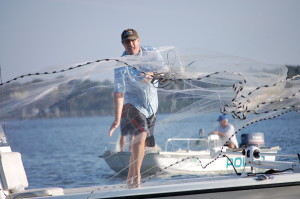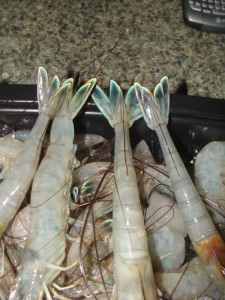Shrimping Florida With A Cast Net
Shrimping Florida in the summer daytime requires only a cast net. Summer cast net shrimping in Florida begins around July and tapers off in the fall. Chasing the summer white shrimp is the hot ticket between Central Florida-Northern Florida. The biggest difference between the winter and summer shrimping is the summer white shrimp are caught in the day time on the outgoing tide and the brown winter shrimp are caught at night. The moon phases also influence the summer shrimp run.
Please take a moment and become familiar with Florida’s FWC Rules & Regulations. Please click this link – FWC shrimping rules and regulations
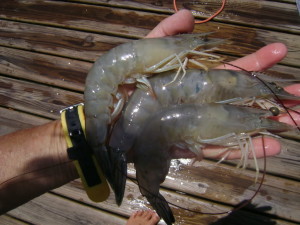 Summer shrimping starts in South Daytona in the Big Tree area late June or early July. They run between marker numbers CM 38 – CM 51. The white shrimp are larger than the summer shrimp and have a more mild flavor compared to the winter brown & pink shrimp.
Summer shrimping starts in South Daytona in the Big Tree area late June or early July. They run between marker numbers CM 38 – CM 51. The white shrimp are larger than the summer shrimp and have a more mild flavor compared to the winter brown & pink shrimp.
We can catch the summer shrimp on both pier and boats. We rely on sonar/depth finder to help us know when a troop of shrimp are crawling near our boats. It is difficult to explain what your looking for on sonar, so let me show you some real pictures. A member took these sonar pictures and I will use them to explain what your looking for using a depth finder.
If your going out  on a boat and you have a depth finder note picture to the left, ragged line edge is the river bottom, there is NO activity above the bottom line line in that picture.
on a boat and you have a depth finder note picture to the left, ragged line edge is the river bottom, there is NO activity above the bottom line line in that picture.
DO NOT CAST on this kind of a mark – NO activity near the bottom line = NO SHRIMP
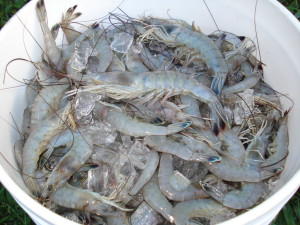 These white summer shrimp are caught by boat and on piers deploying a cast net with at least 30 foot of scope attached to the net to sink into deeper holes. Deploy the net and let it soak on the bottom a few seconds and retrieve. The shrimp will crawl up the net and into the horn (end closest to the line on your wrist).
These white summer shrimp are caught by boat and on piers deploying a cast net with at least 30 foot of scope attached to the net to sink into deeper holes. Deploy the net and let it soak on the bottom a few seconds and retrieve. The shrimp will crawl up the net and into the horn (end closest to the line on your wrist).
Using sonar, you can mark the shrimp on the bottom and have the boat Captain set you up to throw on the troops seen on the depth finder. Turn the sensitivity up on your unit.
- Use the largest size cast net you can throw
- Be prepared to throw it many times
- Buy a cast net with webbing sewn in
- If you buy a cheap net, add duck tape above lead line, both sides
- If taping, do NOT tape the stringers, heat gun & WD 40 removes tape
- Bring culling bucket to release by catch caught by accident.
The popular shrimping cast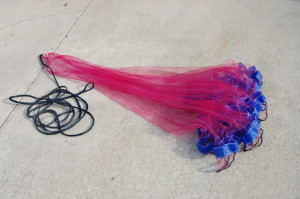 choice will always be a custom made net. We recommend you contact Tim Wade. Call 321-7299537 or 321-508-2836.
choice will always be a custom made net. We recommend you contact Tim Wade. Call 321-7299537 or 321-508-2836.
The webbing sewn on the bottom allows the net to stay open longer which catches more shrimp.
Some people use duck tape and tape both the inside and the outside of the net above the lead line (do not tape the stringers). You can remove the tape using a heat gun or WD 40.
Do not burn the mono-filament.I recommend once you duck tape the net, leave the tape on.
This sonar picture shows a little bit of activity. Follow the bottom line on your sonar, any activity will be clustered around the bottom line. Compare the pic above with NO activity to this picture with SOME activity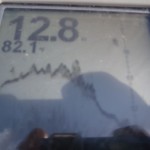 to the right. Look below the number “8” in the 12.8 depth number. You can see thick ridges and spikes of solid matter. Those changes compared to the first picture show a “little” cloud of shrimp and it is well worth throwing a cast net on this mark.
to the right. Look below the number “8” in the 12.8 depth number. You can see thick ridges and spikes of solid matter. Those changes compared to the first picture show a “little” cloud of shrimp and it is well worth throwing a cast net on this mark.
What we all want to see is saturation of shrimp on the bottom so that when we cast, we get 100-200 shrimp per cast. But, do not hold out for those saturated marks, you may be waiting awhile. Cast on any mark that is close to the bottom. If the mark is above the bottom, it is most likely a pod of bait fish. Sometimes you will pull up by catch included with the shrimp, cull out the by catch out and release them safely back into the river.
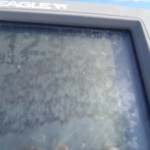 This sonar picture to the left is what we all want to see. Note the dots, this is a heavy troop movement of shrimp coming through. This can yield 100-200 shrimp a throw.
This sonar picture to the left is what we all want to see. Note the dots, this is a heavy troop movement of shrimp coming through. This can yield 100-200 shrimp a throw.
The white shrimp have a signature “blue and green” tail. They molt often and are known to feel “mushy” in the warm river water temperatures. They make a great photo shoot because of their long antennae making it easy to them pick them up by the antennae.
Eventually, all shrimpers get “pricked” enough times from the head horns and/or the tails that we figured out we could handle them by grabbing them by the long antennae.
FACEBOOK SHRIMPING/SCALLOPING INTEL
Scalloping reports on Facebook at the “Florida Shrimping Academy – Tips & Tricks™”. CLICK HERE. This is the largest group for shrimping, scalloping, lobstering and gator hunting.

